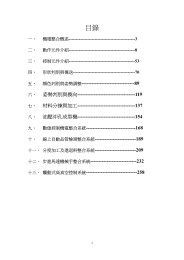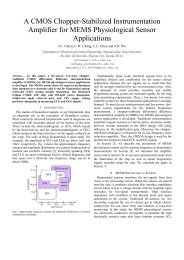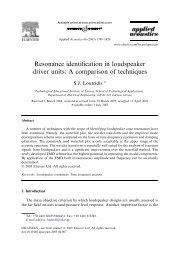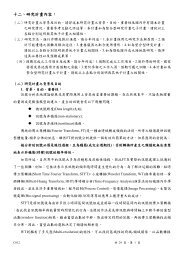IRIS RECOGNITION BASED ON HILBERT–HUANG TRANSFORM 1 ...
IRIS RECOGNITION BASED ON HILBERT–HUANG TRANSFORM 1 ...
IRIS RECOGNITION BASED ON HILBERT–HUANG TRANSFORM 1 ...
You also want an ePaper? Increase the reach of your titles
YUMPU automatically turns print PDFs into web optimized ePapers that Google loves.
Main Frequency Center<br />
0.06<br />
0.05<br />
0.04<br />
0.03<br />
0.02<br />
0 20 40 60 80<br />
Orientation<br />
100 120 140 160<br />
Iris Recognition Based on Hilbert–Huang Transform 637<br />
Original features<br />
Noise features<br />
(a)<br />
Energy<br />
500<br />
400<br />
300<br />
200<br />
Original features<br />
Noise features<br />
0 20 40 60 80<br />
Orientation<br />
100 120 140 160<br />
(b) (c)<br />
Fig. 12. (a) The original iris image; (b) the main frequency centers of 18 orientations in I1 of the<br />
original normalized image (“o”) and those of the noisy normalized image (“•”); (c) the energies<br />
of 18 orientations in I1 of the original normalized image (“o”) and those of the noisy normalized<br />
image (“•”).<br />
4. Experimental Results<br />
To evaluate the performance of the proposed method, we applied it to the widely<br />
used database named CASIA iris database. 1 The database includes 2255 iris images<br />
from 306 different eyes (hence, 306 different classes). The captured iris images are<br />
8-bit gray images with a resolution of 320 × 280.<br />
4.1. Performance of the proposed method<br />
For each iris class, we choose three samples taken at the first session for training and<br />
all samples captured at the second and third sessions serve as test samples. Therefore,<br />
there are 918 images for training and 1337 images for testing. Figure 13(a)<br />
describes variations of the correct recognition rate (CRR) with changes of dimensionality<br />
of the reduced feature vector using the LDA. From this figure, we can see<br />
that with increasing dimensionality of the reduced feature vector, the recognition<br />
rate also increases rapidly. However, when the dimensionality of the reduced feature

















